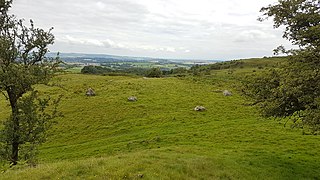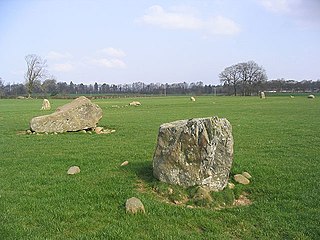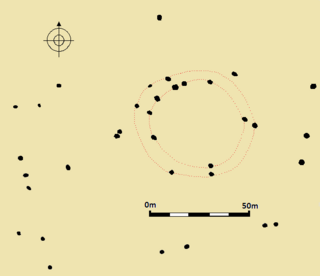This is a list of stone circles located in the Dumfries and Galloway council area. It is compiled from Aubrey Burl's 'County Gazetteer of the Stone Circles in Britain, Ireland and Brittany' [1] and the Royal Commission on the Ancient and Historical Monuments of Scotland's 'Canmore' database. [2] Between them, these two sources list 61 stone circles in the region. Many of these have been destroyed, some remains have not been conclusively identified as stone circles, some were dubious before their destruction and some have not been located by modern surveys.
The following sites are the best preserved:
- Cauldside Burn
- Claughreid
- Easthill
- Girdle Stanes
- Glenquicken
- Loupin Stanes
- Seven Brethren
- Standing Stones of Glenterrow
- Torhouskie
- Twelve Apostles
- Whitcastles
| Name | Image | Grid reference Coordinates | Former county Parish | Notes |
|---|---|---|---|---|
| Airdrie | NX 966 587 54°54′46″N3°36′49″W / 54.912725°N 3.613694°W | Kirkcudbrightshire Kirkbean | A stone circle was recorded in the Old Statistical Account for the parish in 1794 and thirty years later by George Chalmers, but by 1893 the circle could not be found nor was there any local knowledge of the site. [3]
| |
| Bagbie | NX 4979 5639 54°52′47″N4°20′34″W / 54.879681°N 4.342786°W | Kirkcudbrightshire Kirkmabreck | ||
| Bombie | NX 7079 5018 54°49′47″N4°00′47″W / 54.829781°N 4.01292°W | Kirkcudbrightshire Kirkcudbright |
| |
| Booth's Burn, Kirkslight Rig | NY 2221 8837 55°11′01″N3°13′23″W / 55.183518°N 3.223108°W | Dumfriesshire Hutton and Corrie | ||
| Branteth | NY 28 75 55°04′08″N3°07′16″W / 55.068796°N 3.121181°W | Dumfriesshire Kirkpatrick-Fleming |
| |
| Broathill | NY 26 69 55°00′53″N3°09′03″W / 55.014598°N 3.150946°W | Dumfriesshire Kirkpatrick-Fleming |
| |
| Burntscarth Green Farm | NX 9898 8018 55°06′21″N3°35′06″W / 55.105747°N 3.584863°W | Dumfriesshire |
| |
| Carlin Stone | NX 3255 4971 54°48′51″N4°36′26″W / 54.814238°N 4.60734°W | Wigtownshire Mochrum | ||
| Cauldside Burn | NX 5295 5711 54°53′14″N4°17′38″W / 54.887086°N 4.293943°W | Kirkcudbrightshire Anwoth | ||
| Clachanmore | NX 083 467 54°46′44″N4°58′54″W / 54.778958°N 4.981531°W | Wigtownshire Stoneykirk |
| |
| Claughreid | NX 5178 5600 54°52′36″N4°18′42″W / 54.876774°N 4.311595°W | Kirkcudbrightshire Kirkmabreck | ||
| Claywarnies | NX 10 71 55°00′07″N4°57′52″W / 55.00189°N 4.96443°W | Wigtownshire Inch |
| |
| Drumfern | NX 3999 7099 55°00′28″N4°30′13″W / 55.007715°N 4.503519°W | Kirkcudbrightshire Minnigaff | ||
| Drummore | NX 6884 4597 54°47′29″N4°02′29″W / 54.791465°N 4.041347°W | Kirkcudbrightshire Kirkcudbright | ||
| Easthill | NX 9193 7388 55°02′52″N3°41′35″W / 55.047673°N 3.692922°W | Kirkcudbrightshire Lochrutton | ||
| Ernespie | NX 7747 6321 54°56′55″N3°54′52″W / 54.948487°N 3.91454°W | Kirkcudbrightshire Kelton | ||
| Foregirth Farm | NX 95 83 55°08′05″N3°38′26″W / 55.134801°N 3.640683°W | Dumfriesshire |
| |
| Glaisters | NX 761 801 55°06′01″N3°56′33″W / 55.100252°N 3.942559°W | Kirkcudbrightshire Kirkpatrick Durham |
| |
| Glenjorrie | NX 206 581 54°53′09″N4°47′51″W / 54.885829°N 4.79761°W | Wigtownshire Old Luce |
| |
| Girdle Stanes |  | NY 2535 9615 55°15′14″N3°10′33″W / 55.253898°N 3.175867°W | Dumfriesshire Eskdalemuir | |
| Glenquicken |  | NX 5096 5821 54°53′51″N4°19′44″W / 54.897385°N 4.328997°W | Kirkcudbrightshire Kirkmabreck | |
| Glenquicken Moor 1 | NX 5079 5830 54°53′50″N4°19′42″W / 54.897131°N 4.328202°W | Kirkcudbrightshire Kirkmabreck | ||
| Glenquicken Moor 2 | NX 5074 5833 54°53′51″N4°19′44″W / 54.897385°N 4.328997°W | Kirkcudbrightshire Kirkmabreck |
| |
| Glenturk | NX 424 579 54°53′29″N4°27′29″W / 54.891381°N 4.458009°W | Wigtownshire Wigtown |
| |
| Greystone Park | NX 9798 7690 55°04′34″N3°35′58″W / 55.07608°N 3.599354°W | Dumfriesshire Dumfries | ||
| High Auchenlarie | NX 5395 5342 54°51′15″N4°16′35″W / 54.854246°N 4.276497°W | Kirkcudbrightshire | ||
| Holm of Daltallochan |  | NX 5528 9422 55°13′16″N4°16′35″W / 55.220978°N 4.276488°W | Kirkcudbrightshire Carsphairn | |
| Kirkbean Parish | NX 97 59 54°55′11″N3°36′03″W / 54.919637°N 3.600708°W | Kirkcudbrightshire Kirkbean |
| |
| Kirkgunzeon | NX 8657 6668 54°58′55″N3°46′26″W / 54.981808°N 3.773912°W | Kirkcudbrightshire Kirkgunzeon | ||
| Kirkhill | NY 1396 9592 55°15′00″N3°21′18″W / 55.249974°N 3.354933°W | Dumfriesshire Wamphray | ||
| Kirkmadrine | NX 0801 4848 54°47′40″N4°59′16″W / 54.794401°N 4.987881°W | Wigtownshire Stoneykirk |
| |
| Knockshinnie | NX 6822 4517 54°47′03″N4°03′02″W / 54.784118°N 4.05062°W | Kirkcudbrightshire Kirkcudbright | ||
| Laggangarn | NX 2223 7166 55°00′28″N4°46′53″W / 55.007701°N 4.781301°W | Wigtownshire | ||
| Little Balmae | NX 691 447 54°46′50″N4°02′10″W / 54.780544°N 4.036054°W | Kirkcudbrightshire Kirkcudbright | ||
| Loch Mannoch 1 | NX 6628 6143 54°55′47″N4°05′18″W / 54.929626°N 4.088299°W | Kirkcudbrightshire Tongland | ||
| Loch Mannoch 2 | NX 663 615 54°55′50″N4°05′14″W / 54.930676°N 4.087339°W | Kirkcudbrightshire Tongland |
| |
| Lochmaben Stane |  | NY 3123 6600 54°59′02″N3°04′34″W / 54.983875°N 3.076073°W | Dumfriesshire Gretna | |
| Longcastle | NX 3824 4810 54°48′06″N4°31′05″W / 54.801653°N 4.517989°W | Wigtownshire Kirkinner | ||
| Loupin Stanes 1 |  | NY 2570 9663 55°15′30″N3°10′14″W / 55.258263°N 3.170489°W | Dumfriesshire Eskdalemuir | |
| Loupin Stanes 2 | NY 256 966 55°15′30″N3°10′17″W / 55.258389°N 3.171358°W | Dumfriesshire Eskdalemuir |
| |
| Loupin Stanes 3 | NY 258 965 55°15′27″N3°10′05″W / 55.257521°N 3.168186°W | Dumfriesshire Eskdalemuir |
| |
| Mains of Southwick | NX 93 57 54°54′03″N3°39′44″W / 54.900834°N 3.662346°W | Kirkcudbrightshire Colvend and Southwick |
| |
| Miltonise | NX 1925 7405 55°01′41″N4°49′46″W / 55.028078°N 4.829349°W | Wigtownshire New Luce | ||
| Morton Old Church | NX 8902 9696 55°15′16″N3°44′51″W / 55.25433°N 3.747485°W | Dumfriesshire Morton |
| |
| Newlands | NX 96 85 55°09′11″N3°37′33″W / 55.152976°N 3.625735°W | Dumfriesshire |
| |
| Park, Tongland |  | NX 6996 5609 54°52′58″N4°01′43″W / 54.882642°N 4.028495°W | Kirkcudbrightshire Tongland | |
| Queen Mary's Bridge | NX 7030 5476 54°52′15″N4°01′21″W / 54.870786°N 4.022601°W | Kirkcudbrightshire Tongland |
| |
| Seven Brethren | NY 2171 8269 55°07′57″N3°13′46″W / 55.132411°N 3.229387°W | Dumfrieshire Tundergarth | ||
| Shore Plantation | NX 6750 4636 54°47′41″N4°03′44″W / 54.794615°N 4.062352°W | Kirkcudbrightshire Kirkcudbright |
| |
| Standing Stones of Balmennoch | NX 06 57 54°52′29″N5°01′03″W / 54.874719°N 5.017445°W | Wigtownshire Inch | ||
| Standing Stones of Glenterrow |  | NX 1453 6251 54°55′22″N4°53′44″W / 54.922772°N 4.895622°W | Wigtownshire Inch | |
| Steeps Park | NX 248 531 54°50′33″N4°43′45″W / 54.842437°N 4.72918°W | Wigtownshire Old Luce | ||
| Stroan Loch | NX 640 709 55°00′52″N4°07′40″W / 55.014467°N 4.127666°W | Kirkcudbrightshire Kells | ||
| Strongassel | NX 5923 8684 55°09′21″N4°12′39″W / 55.155854°N 4.210771°W | Kirkcudbrightshire Kells | ||
| Templand Mains | NX 8771 9396 55°13′38″N3°46′01″W / 55.227089°N 3.766889°W | Dumfriesshire Closeburn | ||
| The Thieves | NX 4044 7159 55°00′48″N4°29′49″W / 55.013246°N 4.496825°W | Kirkcudbrightshire Minnigaff | ||
| Three Piked Stane | NY 2170 6787 54°59′57″N3°13′32″W / 54.999266°N 3.225467°W | Dumfriesshire Annan | ||
| Torhouskie 1 |  | NX 3825 5649 54°52′37″N4°31′21″W / 54.876979°N 4.52253°W | Wigtownshire Wigtown | |
| Torhouskie 2 | NX 3820 5644 54°52′35″N4°31′24″W / 54.876514°N 4.52328°W | Wigtownshire Wigtown | ||
| Twelve Apostles |  | NX 9470 7940 55°05′52″N3°39′06″W / 55.09785°N 3.651629°W | Dumfriesshire | |
| Wallace's Putting Stone | NX 7016 4381 54°46′21″N4°01′12″W / 54.77241°N 4.019865°W | Kirkcudbrightshire Kirkcudbright |
| |
| Westerkirk Mains | NY 29 91 55°12′46″N3°06′34″W / 55.212687°N 3.109507°W | Dumfriesshire Westerkirk | ||
| Whitcastles |  | NY 2240 8806 55°10′51″N3°13′12″W / 55.180763°N 3.220039°W | Dumfriesshire Hutton and Corrie |
|
| Windy Edge | NY 4304 8389 55°08′46″N2°53′42″W / 55.146108°N 2.895135°W | Dumfriesshire Canonbie |













